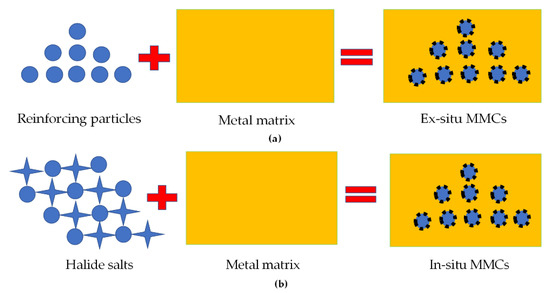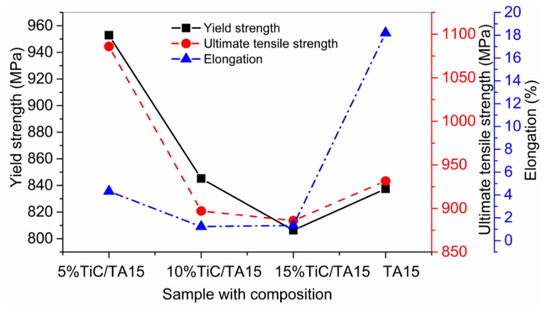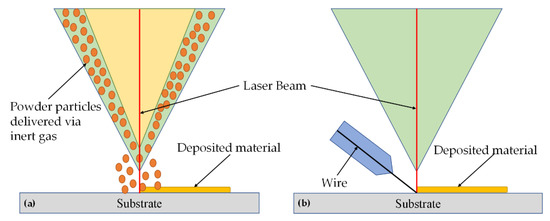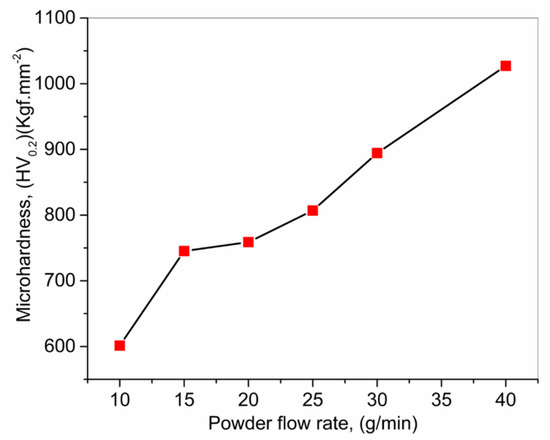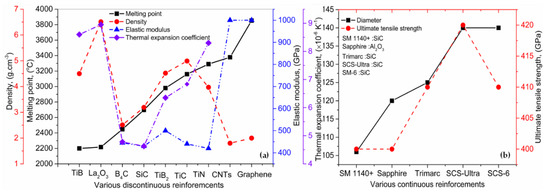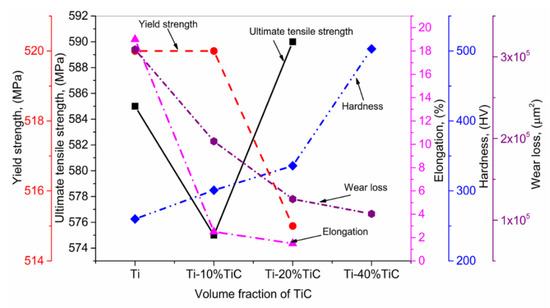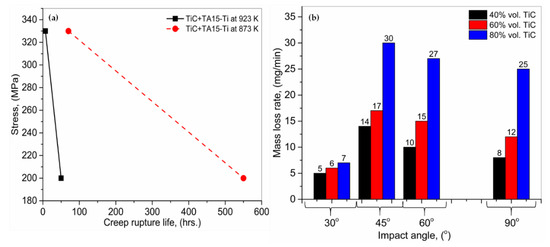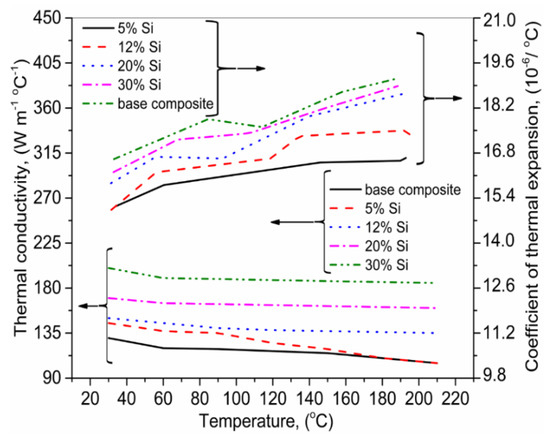Metal matrix composites (MMCs) present extraordinary characteristics, including high wear resistance, excellent operational properties at elevated temperature, and better chemical inertness as compared to traditional alloys. These properties make them prospective candidates in the fields of aerospace, automotive, heavy goods vehicles, electrical, and biomedical industries. MMCs are challenging to process via traditional manufacturing techniques, requiring high cost and energy. The laser-melting deposition (LMD) has recently been used to manufacture MMCs via rapid prototyping, thus, solving these drawbacks. Besides the benefits mentioned above, the issues such as lower ultimate tensile strength, yield strength, weak bonding between matrix and reinforcements, and cracking are still prevalent in parts produced by LMD. In this article, a detailed analysis is made on the MMCs manufactured via LMD. An illustration is presented on the LMD working principle, its classification, and dependent and independent process parameters. Moreover, a brief comparison between the wire and powder-based LMDs has been summarized. Ex- and in-situ MMCs and their preparation techniques are discussed. Besides this, various matrices available for MMCs manufacturing, properties of MMCs after printing, possible complications and future research directions are reviewed and summarized.
MMCs are usually composed of a minimum of two types of materials, a metal matrix and a dispersed phase of metal, ceramic, or polymer [
2]. They can be classified into ex- and in-situ MMCs [
22,
70]. a presents the ex-situ MMCs process, in which the reinforcements, usually particulates, are manufactured and mixed externally into the metal matrix. In such MMCs, the reinforced in the form of particulates are repeatedly splintered and cold-welded, thus, making them potential candidates for the SLS process. On the other hand, b exhibits that in-situ MMCs are manufactured by a chemical reaction between the halide salts and metal matrix, which are thermodynamically more stable than ex-situ MMCs. In-situ MMCs show compatible, strong interfacial bonding and better mechanical properties as compared to ex-situ MMCs. Such MMCs are the potential candidates for SLM and LMD processes. There are various advantages of the MMCs, but potential difficulties, including gas entrapment, particle accruement, and micro- and macro-cracks, play obstacles to produce fully dense MMCs.
Figure 5. The graphical illustration of MMCs (
a) ex-situ (
b) in-situ; based on the data provided in Ref. [
22,
70].
MMCs Mixing Techniques
In the literature, various MMCs mixing techniques are available. The central perspective of these processing techniques is to achieve a standardized dispersal of the reinforcements within a matrix to achieve a defect-free microstructure. collects the various MMCs mixing techniques.
Table 3. Mixing techniques for MMCs.
In the case of LMD, the matrix and reinforcements, both are added in the powder form. Therefore, in this literature, more focus has been put on the powder metallurgy. Lanfant et al. [
89] developed MMCs using Ti (matrix) + Al
2O
3 (nano-reinforcements) via the LMD process. A combination of Impakt powder and conventional powder feeding system was used to directly inject the Al
2O
3 nanoparticles into Ti-matrix to increase the hardness, locally. Mechanical tests were carried out; the results showed that the addition of Al
2O
3-nanoparticles (0–14 wt.%) within Ti-matrix could exponentially increase the hardness from 100 HV to 650 HV. Liu et al. [
90] considered the tensile properties of TA15 titanium (matrix) + TiC (10 vol.% reinforcement) at high temperatures. These MMCs were pre-mixed in the form of powder blends. It was found that the MMCs exhibited higher tensile strength (UTS) and lower elongation as compared to the monolithic matrix alloys at 873 K. The UTS decreased from 625 to 342 MPa as the temperature increased from 873 to 973 K. In contrast, the elongation of the MMCs increased from 7% to 18%.
Liu et al. [
48] manufactured titanium matrix composites (TiC + TA15) by the LMD process. Initially, the TiC + TA15 in powder form was mixed with an acetone solution, and then the slurry was dried in an electric oven up to 393 K for two hours to eliminate the acetone solvent. The results are shown in , which indicates that the specimen containing TiC (5 vol.%) presented better yield strength (YS) and UTS. In contrast, the tensile properties of the composites declined with the further increment of TiC (10 and 15 vol.%). The declination in the UTS of the composites is accredited to the premature failure of the TiC reinforcements. It can also be seen that pure TA15 presented better elongation (%) as compared to the composite ones.
Figure 6. TiC + TA15 composites mechanical characteristics, including yield strength, ultimate tensile strength, and elongation; based on the data provided in Ref. [
48].
Cooper et al. [
91] manufactured MMCs with the addition of Al
2O
3 + SiC + TiC (5 wt.%) in the Inconel 625 matrix by the LMD process. A ball mill was used to mix the powders, at a speed of 150 rpm for one hour, until the powders appeared well-mixed visually. On the one hand, the material hardness increased up to 130%. On the other hand, the number of pores and cracks increased with the addition of SiC. In contrast, no appreciable effect upon material’s hardness was found with the addition of Al
2O
3.
Metal Matrix Composites (MMCs) Deposited by Wire and Powder Particles Feedstock
The LMD process can be further classified based upon the type of feedstock material. presents the two deposition techniques derived from the LMD process. In a, the powder is fed coaxially along the laser beam while the lateral wire feeding into the melt pool can be observed in b [
92].
Figure 7. The LMD process: (
a) coaxial powder feeding and (
b) lateral wire feeding; based on the data provided in Ref. [
92].
Processes, as mentioned earlier, own some pros and cons, which are summarized in [
93,
94,
95,
96,
97].
Table 4. Comparison between the powder and wire-based LMDs.
The pros and cons of combined powder- and wire-based LMDs are presented in [
92].
Table 5. Integration of powder- and wire-based LMDs.
Farayibi et al. [
98] investigated the LMD of Ti6Al4V (wire) + tungsten carbide (WC), in powder form, fed concurrently into the melt pool generated on a Ti6Al4V substrate via the laser beam. The WC particulates participated as the strengthening agent within Ti6Al4V, thus, improving the deposited MMCs’ hardness and wear resistance. shows the microhardness of the deposited material, in which the powder flow was increased (10–40 g/m), while the wire feed rate kept constant (800 mm/min). It can be analyzed that with the increment in powder flow, the hardness of the deposited MMCs rises significantly (600–1000 HV).
Figure 8. Effect of WC powder flow rate on microhardness; based on the data provided in Ref. [
98].
Farayibi et al. [
99] developed a new MMC using Ti6Al4V + titanium diboride in the powder form via a satelliting method. The resulted mixture consisted of large Ti6Al4V particles, enclosed within finer needle-shaped TiB structures, presented an improved hardness. The microstructural characterization exposed that the composite consisted of TiB eutectic precipitates in an α+β-Ti-matrix. They contained the incompletely melted Ti6Al4V + TiB
2 particulates. The satelliting of TiB
2 particles onto Ti6Al4V surfaces notably enhanced the dispersion of the composite, which was characterized by the arbitrarily oriented and uniformly distributed TiB needles within the microstructure. The composites’ hardness, when fabricated by this technique, was in between 440 to 480 HV.
Different Laser Sources for In-Situ MMCs Syntheses by LMD
Various studies to manufacture MMCs by a unique laser source have been proposed. Ramakrishnana and Dinda [
100] manufactured MMCs using Al (82 wt.%) + W (18 wt.%) via the LMD technique. A laser beam (diode laser Laserline LDM 2000-40, 978 nm) of 900 W, in combination with three scanning speeds (1.5, 6, and 12 mm/s), was used for the MMCs fabrication. The hardness of the developed MMCs increased up to 50% in comparison with pure aluminum. A finer microstructure was found at 12 mm/s scanning speed as compared to 1.5 and 6 mm/s scanning speeds. Zhenglong et al. [
101] prepared TiB
2 (particulate) + AA7075 (matrix) MMCs using the LMD technique. A laser beam (IPG fiber laser, YLS-5000) with 800 W and 10 mm/m scanning speed was used in the process. The results exhibited that the grain dimensions decreased after adding TiB
2 due to heterogeneous nucleation. In comparison to the unreinforced AA7075 sample, TiB
2 + AA7075 MMCs showed an elevated hardness. The hardness of the MMC with TiB
2 (4 wt.%) was found to be 127.8 HV, while the grain size was reduced up to 16.8 μm.
Li et al. [
55] designed and fabricated novel MMCs using α-Fe, vanadium (V), victorium (VC), and chromium carbides (Cr
7C
3, Cr
23C
6) via the LMD process. The V was used in 9, 12, and 15% (wt.%), respectively. For fabrication, a ytterbium laser source with 2.2 kW and 8 mm/s scanning speed was used. The results indicated that the VC particles provided adequate space for the heterogeneous nucleation of α-Fe and Cr
23C
6, during the solidification of the molten material, which resulted in refined grain structures. The microhardness of the three specimens was in the range of 521–603 HV. The sample having V with 12 (wt.%), resulted in the lowest wear rate (5.011 × 10
−6 mm
3/Nm) among all the tested samples.
Matrices for MMCS
Titanium-Based MMCs (TMCs)
Titanium alloys have various aerospace, marine, biomedical, structural and industrial applications. They owe excellent strength to weight ratio, malleability, formability, deterioration resistance, and biological compatibility characteristics. However, these alloys yield reduced hardness and wear attributes. A suitable way to increase the hardness and tribological characteristics of Ti-alloys is to mix the Ti-matrix with tough precipitates to achieve Ti-based composites (TMCs). These can be classified into two sub-categories based on the type of reinforcement: (i) continuous reinforced TMCs (ii) discontinuous (particles) reinforced TMCs [
102,
103,
104]. summarizes the continuous and discontinuous TMCs formation techniques regarding illustration, advantages, and disadvantages.
Table 6. Continuous and discontinuous TMCs formation techniques.
In the last few years, the discontinuously strengthened Ti-composites have experienced rapid expansion. They have an elevated strength, toughness, wear resistance, and thermal reliability as compared to pure Ti-alloys. Therefore, they are potentially considered for applications, including aerospace and automotive. Different particulates have been selected for reinforcement so far such as TiB
2, TiN, B
4C, ZrC [
42,
104], nano-SiC [
114], TiB, TiC [
115,
116], Al
2O
3 [
117], and Si
3N
4, which were found unstable due to the formation of titanium silicide and carbon nanotubes [
118,
119,
120]. For the continuous fibers, TMCs using boron reinforcing fibers (coated with silicon carbide) were produced; however, these fibers are expensive as compared to the other fibers, which leads to discontinuation of TiB fibers [
104,
121,
122]. Besides this, various researches have been carried out using SiC [
123,
124,
125,
126,
127], carbon [
104,
128,
129], SCS-6 and Sigma [
130,
131] reinforced fibers.
a displays the mechanical and physical properties of various discontinuous TMCs. It can be seen that the TiB and graphene present the least and highest melting point, respectively, as compared to the other discontinuous reinforcements (DRFs). It means that a low amount of laser energy will be needed to melt down the TiB. In contrast, an opposite behavior can be observed for graphene. Moreover, La
2O
3 presents the highest density, while graphene possesses the least density value. To the best of our knowledge, the elastic modulus of TiB and La
2O
3 containing MMCs are not reported in the literature, which identifies the potential area for future research. The B
4C, SiC, TiB
2, TiC, and TiN have almost the same elastic moduli; but, the carbon nanotubes (CNTs) and graphene present the highest elastic moduli as compared to the rest of DRFs. Similarly, the La
2O
3 has the highest thermal expansion coefficient as compared to the rest of DRFs. b shows a comparison of various continuous reinforcements (CRFs) regarding their diameter and ultimate tensile strength (UTS). The two major types of CRFs, including SiC and Al
2O
3, have been presented. The majority of the CRFs such as SM 1140+, trimarc, SCS-ultra, and SM-6 belong to the SiC category, while sapphire belongs to the Al
2O
3 type. The output explains that SCS-ultra, with a diameter of 140 µm, shows the maximum UTS. In contrast, for the rest of the CRFs, a compromise should be reached between the particulate size and UTS. By keeping in view the trend presented in the , one can conclude that the proper selection of DRFs and CRFs has to be made based on the specific requirements, and a compromise should be made between the thermal and physical properties [
104].
Figure 9. Properties of various TMCs (
a) discontinuous and (
b) continuous reinforcements; based on the data provided in Ref. [
104].
Nickel-Based MMCs (NMCs)
Ceramic reinforced nickel matrix composites, also known as NMCs, usually possess high fatigue and corrosion resistance with better hardness and wear resistance properties as compared to the simple nickel matrix. They are considered to be prospective materials in aerospace, biological, and petrochemical manufacturing due to above-mentioned properties. TiC strengthened NMCs via LMD were produced by Hong et al. [
132]. They found that the existence of TiC was beneficial to refine grain size, from 34.1 µm to 27.2 µm. Moreover, the results displayed that the high energy can lead to an effective Marangoni convection confined by the melt pool, which induces refined and normalized spreading of TiC reinforcements. Thus, resulting in improved wear resistance and malleability. Furthermore, an increment in the thermal energy input per unit length resulted in uneven columnar dendrites formation, declining the wear and tensile properties of NMCs. Li et al. [
133] produced Ni + TiC NMCs by LMD. A total of three TiC compositions, including 20, 40, and 60 (vol.%), were selected. The influence of TiC vol.% on phase transformation, microstructure evolution, hardness, and wear resistance, was analyzed. The analyses exhibited that the composites consisted of TiC + Ni phases, demonstrating that TiC was produced through in-situ reaction. Moreover, TiC particulate size increased from 3 to 10 μm, when the TiC (vol.%) was enhanced from 20 to 60%. In addition, the hardness was improved from 365.6 HV
0.3 to 1897.6 HV
0.3, while the value of wear resistance changed from 20 to 6 × 10
−3 g.
Other Metal Matrix Composites
In the LMD process, the rapid heating and solidification lead to the warpage, delamination, and cracks. Li et al. [
134] carried out a study on the usage of invar. The experimental results showed that TiC reinforced invar, with the 64 wt.% Fe and 36 wt.% Ni composition, has a low thermal expansion coefficient, improved rigidity, and YS. Xiong et al. and Picas et al. [
135,
136,
137] manufactured WC + Co using LENS. An improved microstructure, wear resistance, and mechanical properties were found with the addition of WC in Co. Choi and Maumder [
138] reported a study on the manufacturing of Fe + Cr + C + W MMCs via the DMD, thereby, producing an innovative wear-resistant material. The results explained that the conformation and volume proportion of carbides could easily be handled by regulating the pre-heating temperature, input power density, and scanning speed. The matrix participation was carried out by M
6C and M
23C
6 type carbides; the rhombus-shaped M
6C carbides showed better tribological properties. Zhong et al. [
139] synthesized the Ni-Al intermetallic layers and TiC (particulates) MMCs by laser cladding. The powder particles were added coaxially. The printed layers were cracks free and metallurgically bond to the substrate. The microstructure of the layers was mainly composed of β-Ni-Al phase and a few γ-phases. Moreover, un-melted dispersive fine precipitates of TiC particles and refined β-Ni-Al phase matrix were found in the composites. The hardness test shows that the microhardness for Ni-Al intermetallic layers was equal to 355 HV
0.1, and 538 HV
0.1 for Ni-Al+ TiC matrix composites.
Properties of MMCs
MMCs present remarkable characteristics, which makes them applicable in the fields of aerospace, automotive, heavy goods vehicles, electrical, and biomedical [
140]. Few properties of MMCs are reviewed below.
Mechanical Properties: Hardness, Ultimate Tensile Strength (UTS), Yield Strength (YS), Elongation, and Wear
MMCs present superior properties including hardness, YS, and UTS in comparison to the base alloys. Li et al. [
141] manufactured MMCs through the LMD by feeding the WC powder particulates along with titanium wire into the melt pool generated by the laser beam. Major process parameters, including wire feeding rate, powder flow, and the laser power were used in the analyses. The microhardness of the MMCs was 500 HV
0.2, which is much higher than the titanium alloys (320 HV
0.2). It indicates that the presence of the WC + TiC phases within the printed layer improved the hardness and abrasive resistance. Bi et al. [
142] carried out the deposition of inconel 625 + TiC nano-powders using the LMD. The mechanical properties were investigated. Three different compositions of TiC + inconel 625, including 0.25/99.75, 0.50/99.50 and 1.00/99.00 (wt.%), were synthesized. The hardness, UTS, YS, and elongation are shown in a. It can be seen that the hardness, UTS, and YS increased proportionally with the increment in the quantity of TiC particulates (wt.%). However, elongation presented random behavior with the increment in TiC particulates (wt.%). The maximum elongation was exhibited by 0.50/99.50 composition. Gopagoni et al. [
143] processed Ni (80 wt.%) + Ti (10 wt.%) + C (10 wt.%) MMCs via LENS technique. The manufactured MMCs showed the eutectic TiC and FCC-TiC structures. The tribological and mechanical analyses were conducted. The stationary friction coefficient was found equal to 0.50, inferior to pure Ni. Moreover, the hardness increased substantially up to 370 VHN, proving them a potential candidate for surface engineering operations. Crack-free functionally graded MMCs composed of TiC particulates + Ti6Al4V were manufactured by Wang et al. [
56] using LMD. A volume fraction of TiC in between 0–30 (% wt.) was used to analyze the effect of TiC (vol.%) on the microstructure and mechanical characteristics of MMCs. They found that the hardness gradually increased with the increment in TiC (vol.%), which can be attributed to the presence of eutectic + TiC phases. When TiC increased up to 5 (vol.%), the tensile strength enhanced by 12.3% as compared to the Ti6Al4V alloy. Nevertheless, the tensile strength and elongation of the produced MMCs decline as the volume fraction of TiC surpass by 5%. It can be explained that the number of stiff un-melted TiC particulates, amount and dimension of dendritic TiC phases raised with the increment in TiC. These results are presented in b.
Figure 10. (
a) Influence of Nano-TiC particulates on the hardness, ultimate tensile strength, yield strength, and elongation, and (
b) the consequence of TiC (vol.%) on Tensile strength, elongation, and hardness; based on the data provided in Ref. [
56,
142].
Hong et al. [
144] used the LMD to manufacture inconel 718 + TiC MMCs. The influence of the laser energy over the unit length (80–160 kJ/m) on the microstructures and hardness, was analyzed. The TiC experienced a tremendous transformation as the laser energy density increased from 80 to 120 kJ/m. The comparatively coarse polyhedral TiC particulates resulted when the laser energy was up to 100 kJ/m. As the laser energy increased beyond 100 kJ/m, completely liquified smooth TiC particulates were produced. Furthermore, when the laser energy increased beyond 160 kJ/m, the TiC particulates were significantly refined. However, a direct relationship was observed between laser energy input and microhardness for the produced MMCs, as given in a. Sateesh et al. [
145] manufactured MMCs using pre-heated nickel phosphide coated with SiC reinforced particles via the LMD process, under inert nitrogen atmosphere. An inclination in the hardness, UTS, YS, and elongation was observed with the increment in SiC (wt.%). These properties decline dramatically beyond 3 (wt.%) addition of SiC. For a given laser scanning speed and power, the increment in SiC (wt.%) resulted in excessive un-melted SiC particles, leading to the declination of hardness, UTS, YS, and elongation, as shown in b.
Figure 11. (
a) Analyses of laser energy input over the unit length on microhardness, and (
b) influence of SiC reinforcement (wt.%) on hardness, ultimate tensile and yield strengths, and elongation; based on the data provided in Ref. [
144,
145].
Zhang et al. [
146] used the LMD to manufacture Ti + TiC MMCs with various pre-mixed ratios of TiC (10, 20 and 40 vol.%) The mechanical testing, including UTS, YS, elongation, hardness, and wear, were conducted. The results are presented in . It can be observed that the UTS slightly deviates with the accumulation of TiC; meanwhile, YS declines quickly, which is caused by the existence of solid and stiff TiC particulates. The hardness and wear resistance of the produced MMCs raised with the increment in TiC volume fraction due to the strengthening effect of the particulates and the optimum bonding between TiC and Ti. Based on the excellent adhesion between TiC + Ti MMCs, such coatings can be deposited on the surfaces, where superior wear resistance is required. The LMD process inherits the high laser energy density; moreover, Ti showed an excellent affinity to the Oxygen + Nitrogen, which was absorbed quickly in the interstitials. The combination of the aforementioned facts leads to strength increment. Furthermore, a declination in the elasticity was observed in the MMCs.
Figure 12. Effect of TiC reinforcement (vol.%) on ultimate tensile and yield strengths, elongation, hardness, and wear loss; based on the data provided in Ref. [
146].
provides a summary of the above-mentioned mechanical properties.
Table 7. Summary of MMCs mechanical properties.
Creep Behavior, Erosion Resistance and Thermophysical
Liu et al. [
147] analyzed the creep performance of TA15-Ti + TiC particulates (10.8 vol.%) MMCs at 873 and 923 K, respectively, deposited by the LMD. The creep resistance of the MMCs improved notably due to the accumulation of TiC reinforcing particulates in comparison to the monolithic TA15-Ti alloy designed in between 723 to 773 K. The creep life for TA15-Ti + TiC MMCs at 873 and 923 K, is shown in a. The rupture of the TiC + TA15 MMCs was originated due to the particles’ cracking, interfacial debonding and voiding, which becomes dominant with the temperature elevation. Jiang and Kovacevic [
148] performed a study on the behavior of TiC + H13 tool steel MMCs, manufactured by LMD. The influence of TiC (vol.%) on erosion resistance was analyzed. b shows the erosion rates of the coated layers at different impact angles. For all the coatings, it can be observed that the impact angle influenced the erosion rate considerably. For the 30° impact angle, the lowest erosion rate was observed, followed by a 90° impact angle. The maximum erosion was found at 45° and 60° angles. Moreover, TiC with 80 (vol.%) presented the least erosion resistance, while the coating with 40 (vol.%) showed the highest ones.
Figure 13. (
a) Creep behavior of TiC + TA15-Ti MMCs, and (
b) erosion rates for 40, 60, and 80 (vol.%) TiC + H13 tool steel MMCs at various impact angles; based on the data provided in Ref. [
147,
148].
Lei et al. [
149] used the LMD for Si
p + 6063Al MMCs for 5, 12, 20 and 30 (wt.%) Si contents. The thermophysical properties of MMCs were investigated. The results are shown in . They found that with the increment in Si (wt.%), the thermal conductivity of the MMCs declined due to the decrease in an α-Al phase, which exhibits the high-level conductivity. The thermal expansion coefficient presented an opposite behavior as compared to the thermal conductivity.
Figure 14. The relation between temperature and various fractions of Si on thermal conductivity and thermal expansion coefficient; based on the data provided in Ref. [
149].
Applications of MMCs
The literature survey revealed the following main areas proposed by various studies.
Biomedical
MMCs have outstanding load-bearing and wear resistance properties, which make them interesting for implant applications [
150]. TiN and SiC reinforced TMCs [
151,
152] have been proved for excellent biocompatibility. Hence, they are used for cladding on the metallic substrates to upgrade the biocompatibility of implants. In vitro testing was carried out to assess the biocompatibility of the deposited layers. The results showed an excellent cell to material interaction, and no toxicity was found. It showed that they could be used for load-bearing implants such as hip, knee and shoulder joints [
151,
152]. Moreover, orthopedic bone prototypes and meshed cranial prostheses implants were successfully developed for biomedical applications [
57,
153,
154].
Wear Resistance
In MMCs, the ceramic reinforcements within the matrix play as the load-bearing element, which can confine the plastic distortion, thus, preventing the matrix from deterioration. It makes MMCs a potential candidate for wear-resistant applications [
5,
155]. The depositions of TiN reinforced MMCs on a Ni-Ti substrate by LMD, in a nitrogen atmosphere, increased the substrate’ wear resistance by a factor of two [
156]. TiB + TiN MMCs were prepared on a Ti-substrate using pre-mixed boron nitride (BN) + Ti6Al4V powders by the LMD. With the increase in the BN content up to 15 (wt.%), the surface hardness increased from 543 to 877 HV, thereby, increasing the wear resistivity of the deposited layers [
157]. The deposition of WC/W
2C + Ni MMCs on steel substrate was carried out via LMD. It was found that an inclination in the WC/W
2C content and a declination in carbide dimension, can enhance the wear resistance of MMCs up to 200 times more than the pure Ni matrix [
158]. The dry friction, along with better contact load, is an increasing demand for aerospace and heavy industries. In simple words, only the high wear resistance is not sufficient. For this difficulty, WC/Co (ceramic reinforcement) + Cu-Sn (solid lubricant) were manufactured by the LMD process. The developed structures presented better wear resistance and low frictional characteristics [
159].
Corrosion and Erosion Resistance
MMCs are used to increase electrochemical corrosion and erosion resistance. For this purpose, Ni
2Si composites were deposited on a steel substrate by the LMD technique [
160]. Immersion and anodic polarization tests were conducted, which proved the deposited layer intermediated better bio- and electrochemical corrosion resistance. The novel layers of TiC + Satellite 6, WC + Co, MoSi
2 + stellate 6, and MoSi
2 + steel matrix composites, were deposited on a metallic substrate to improve erosion wear rate [
161].
Industrial
LMD technology has recently been used to repair brake disks and turbo-engine parts [
162]. In one of the recent studies, LMD was demonstrated as a potential candidate to repair steel dies using the Fe-Cr and Fe-Ni layers [
163]. Moreover, various applications of the LMD have been determined in the fields of aeronautics and refractory [
164]. Furthermore, LMD technique has been tested for the manufacturing of multiple parts, including turbine and compressor blades [
165], nozzle guide vanes [
166], jet engines [
167], casting dies [
168], Z-notches [
169], bearing seats, valves, shafts, cylinders and rods [
170], and seals [
171].
MMCs by the LMD: Strengths, Challenges and Their Potential Solutions
On the one hand, MMCs produced by LMD show excellent hardness, toughness and frictional properties. On the other hand, MMCs loose ductility, YS, and UTS with the addition of ceramic particulates. Mechanical properties of MMCs primarily depend on the adhesion between ceramic reinforcements and metal matrices along with the interface. Zheng et al. [
172,
173] used an effective strategy to overcome such difficulties, by encapsulating ceramic particles within metallic coatings to strengthen the inconel-625 + Ti-6Al-4V MMCs. This method prevents the bunching of ceramic particles within MMCs, thus, effectively reducing the voids and cracks formation in between metal and ceramic intersection. There are various hindrances for obtaining the fully dense and homogenized MMCs. The dense MMCs are restricted due to micro/macro-cracks, gas entrapment, and particulate accumulation during the printing process.
Moreover, if the initially deposited layers are poorly bonded to the substrate, the following layers deposition will result in an up-warp, hence, resulting in manufacturing failure [
174]. Due to rapid heating and solidification in the LMD process, cracks are usually induced due to the large thermal gradient [
175]. These cracks decrease the lifetime of the fabricated parts. The cracks can cause the catastrophic failure of the deposited layers under cyclic loading [
103]. Therefore, it is extremely important to manufacture fully dense parts [
28,
176,
177]. Various methods can solve the problems as mentioned above: (a) Process optimization [
178,
179], (b) integrating the LMD process with assisting technology such as ultrasonic vibration [
180,
181], (c) pre/post-heating the substrate to decrease thermal gradient [
182,
183], (d) adding rare earth oxides to change the melt pool dynamics [
184,
185] and (e) tailoring the novel structures [
186,
187].
Future Research Directions in MMCs
Based on the current review, a few potential areas still need attention from the researchers. In the LMD process, strong bonding between the deposited MMCs layers with the substrate is of great importance to fabricate bulk parts. One of the ways to achieve the desired strength is “process optimization.” However, in situations where process optimization fails, integrating an assisting technology such as ultrasonic vibration with LMD can be a decent alternative to secure an optimum bonding between the deposited layers and substrate.
Moreover, the post-processing needs special tools and high energy, thus, increasing the fabrication cost. This high cost limits the availability of MMCs to niche applications. There is a need to find out a balanced solution between better thermo-mechanical properties and low production cost, which can promote the MMCs effectively.
Depending on the amount of the dispersed phase within the composition, MMCs can display new properties or an enhancement of the existing ones. By simultaneous addition of matrix and reinforcement in powder form, might result in new materials with exciting properties. In addition, parts with complex architecture such as multilayered structures or gradient composition can be easily obtained via in-situ MMCs. Another area to explore is to manufacture the exact composition of MMCs via different laser sources as it may affect microstructure, mechanical, thermal and electrical properties significantly.
LMD is not suitable for the parts with fine geometry in the range of hundred-microns. On the other hand, SLM is a technique appropriate for metal parts with lattice structures and complex geometries. However, LMD scanning heads future developments can allow the obtaining of sub-mm resolutions. Hence, an increase in resolution for the MMCs printing via the LMD is a new area to be explored.
The newest trend in 3D printing is the use of enhanced topology. The CAD/CAM user specifies the part size, restrictions and the acting forces into the dedicated software. With this data, the software calculates and proposes the best shape regarding user’s requirements and the maximum resistance to the forces that will act upon it. However, the shape offered by the software is most of the time, unconventional and convoluted. Conventional casting or pressing techniques are often inappropriate for producing it, while 3D printing, in this case, is a suitable choice for building such parts. LMD printing method can advance this field even more by involving MMCs.
This entry is adapted from the peer-reviewed paper 10.3390/ma13112593
